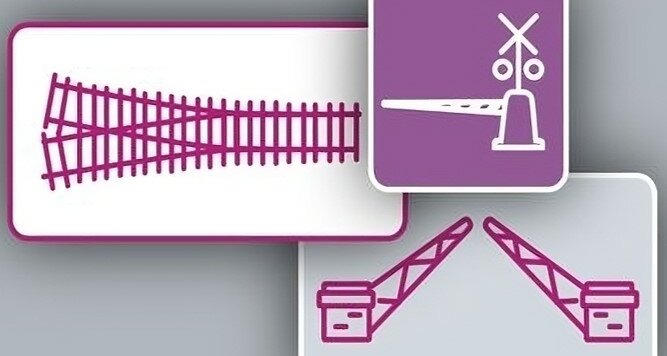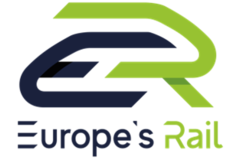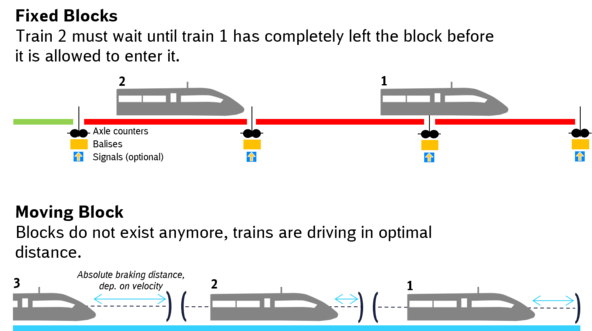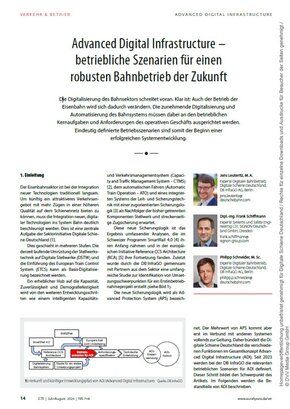
Advanced Digital Infrastructure (ADI)/Moving Block Demonstrator
Together with European partners, Digitale Schiene Deutschland is developing "Advanced Digital Infrastructure", a new, train-oriented train protection system. Trains can then run at individual intervals depending on their current speed and length (so-called "moving blocks").
Information about the Moving Block Demonstrator can be found in the tab below.
Project duration
Our partners

In order to achieve agreed climate targets, even more traffic must be transferred from road to rail. In future, there will be significantly more trains on the existing rail network. Today, the maximum number of trains on the rail network is limited by conventional technology, as trains have to maintain a safe distance from each other due to their long braking distance. For this purpose, a route is divided into fixed, physical block sections. A block is blocked for the following train as long as the preceding train has not left it. The occupancy of these sections is determined with the help of fixed train detection systems on the line, such as axle counters, which determine that the train has completely left the section. Each section must therefore be defined in advance. Changing the sections after commissioning is then only possible with great effort.
This is where the Advanced Digital Infrastructure (ADI) comes in: Each train can be continuously located with its extension on the rail network. Continuous data transmission and greater computing speeds now make it possible to define dynamic block divisions for each train in the same network. Train integrity must be monitored independently by the vehicle. The transfer of the safe train end from the vehicle to ADI enables a denser train sequence and thus an increase in line capacity. Trains can then run at individual intervals depending on their current speed and length (so-called "moving blocks"). At the same time, the technology on the track can be reduced to a minimum. This means fewer disruptions and less maintenance work, which increases reliability and reduces costs.
Implementation of ADI
Merging signal box technology and automatic train control
Today's typical trackside equipment includes a signal box for track safety and a train control system for guiding trains by means of speed specifications (in the vision of Digitale Schiene Deutschland, only the European Train Control System ETCS will be used for this in future). To implement ADI, the functions of interlocking technology and automatic train control (in this case the Radio Block Center) are combined in one system on the infrastructure side. The integration of both systems overcomes the historically grown, different working methods of signal box and ETCS, which lead to a high level of complexity in development and project planning.
Introduction of generic safety logic
Generic safety logic is an important feature of ADI. Generic here means an image of all real route elements in the rail network in a standardized, digital format. A database, the "digital register", contains the digital image of the rail network with all track elements (e.g. points, level crossings) and their properties, such as permitted speed or maximum axle loads. ADI and other systems such as train traffic scheduling access this generic data to carry out rail operations. All necessary topology data is stored in the digital register and made accessible to various systems in a standardized format. By using a standardized data model or the same data basis for all relevant systems, it is possible to move away from the topology that is currently programmed specifically for each signal box. Checks and safety functions in ADI can thus be carried out and defined independently of the specific element in the physical reality. Changes are made centrally in one place. In addition, changes to the rail network can be checked in isolation and carried out without affecting the approval of the safety logic.
Migration and rollout of ADI
Due to the size of the German rail network, a new technology such as ADI can only be introduced gradually. From the outset, ADI considered migration based on different existing equipment levels on the track and vehicles. The external systems installed with the current digital signaling technology can continue to be used with ADI.
In the target state, all trains must send their safe train end position to ADI. Today, only a few trains can determine their train integrity on-board, which means that trains without train integrity messages must also be integrated into the system for a longer period of time. ADI is therefore able to combine both messages from trains and information from conventional track-side sensors such as axle counters to create a clear, safe train position. The flexible use of all available information leads to the best possible performance. Each additional train with a completeness message increases the line capacity without changing the project planning.
European dimension
Currently, different standards and designs of interlocking technology across Europe lead to a very large variety of technologies. Digitale Schiene Deutschland is therefore driving forward the development of ADI as part of European standardization together with partners from industry and rail operators. A joint approach based on the RCA (Reference CCS Architecture) is being designed with European infrastructure operators and standardized through interfaces, technology harmonized, and operational rules standardized.
- Increased line capacity thanks to denser train sequencing and running in "moving block" logic
- Faster project planning and adaptation thanks to the elimination of block logic and the introduction of generic safety logic
- Optimum adaptation to the current operating situation and thus more flexibility and higher operational efficiency thanks to geometric safety logic
- Fewer disruptions and maintenance costs thanks to less technology on the track. This increases reliability and reduces costs.
- Increases the European interoperability of the rail network
In Scope:
A demonstrator project as part of the ERJU Innovation Pillar (R2DATO) for a train-oriented safety logic (based on the ADI concepts), which, among other things, enables driving in the "moving block". The safety logic combines the functionalities of RBC and signal box in one system.
Procedure:
Incremental approach in which the "specification-development-testing" cycle is run through several times. The aim is to realize up to five releases, each with an extended range of functions. Each release concludes with a demonstration in the simulation and/or in the test field.
Partners:
The project is being implemented in collaboration with SBB, ÖBB and GTS (formerly Thales).
Duration:
11/2022 – 05/2026
Objectives:
- Demonstrate the feasibility of the underlying architecture and the approach of a generic safety logic
- Demonstrate the advantages of a train-oriented safety logic (in comparison with a block-centric solution)
- Demonstrate suitability for ETCS-equipped trains
- Demonstrate the flexibility of the system regarding the use of train- and track-side inputs for localization
- Demonstrate driving in the "moving block", both in the form of simulation and field tests in the Digital Test Field Railway in the Ore Mountains
Out of scope:
- European Committee for Electrotechnical Standardization/SIL-4 compliant development
- Product approval
- Full range of functions for all operational use cases
Development of ADI pilot (focus on S2 Remstalbahn test track)
An ADI pilot is being developed on the S2 test route, known as the Remstalbahn. The aim of the project is to integrate new technologies into the system. The focus is on the technical perspective of the backup logic and the development of a roadmap for subsequent generations.
The aim is to demonstrate
- that ADI is technically feasible (TRL8), the generic safety logic is approvable and moving blocks lead to an increase in capacity.
- that at least the same performance target as under ETCS L2 oS is achieved. With a capacity increase of 20%, a train can run every 5 minutes (platform track) or every 2 minutes (other tracks). It is essential that operational quality is maintained even in the event of deviations from regular operations.
- that operational flexibility can be increased without the need for separate planning of new routes and that certain incidents (e.g. temporary speed restrictions) can be resolved semi-automatically.
Project data: :
Start: 2024
End: 2030
Videos
Advanced Digital Infrastructure: Explainer
The video clearly explains the technology and the benefits of “Advanced Digital Infrastructure”. Each train can be continuously localized with its extension on the track network. Continuous data transmission and higher computing speeds now make it possible to define dynamic block divisions for each train in the same network in order to run trains at individual intervals depending on their current speed and length (so-called “moving blocks”).
Publications
-
Advanced Digital Infrastructure - Operational Scenarios for Robust Rail Operations of the Future | July, August 2024 (only in German)
As the successor to the previous control and safety technology, the “Advanced Digital Infrastructure” (ADI) will enable trains to run at the smallest possible distances from each other in future (so-called moving blocks). This will increase the capacity of the existing network. This article introduces the concept of ADI and describes the procedure for creating operating scenarios in detail.
Source: Eisenbahntechnische Rundschau
-
Article in "EI - DER EISENBAHNINGENIEUR" | Blocks were yesterday - opportunities for a train-centric LST | 11/22 (only in German)
The European railroads are working on a holistic solution for future control and safety technology (LST) that moves away from protection via fixed blocks and is geared towards individual train movements. With the development of such a train-centric safety logic, the "Advanced Protection System (APS)", they are responding to challenges such as increasing capacity and making operations more flexible. Deutsche Bahn AG has been heavily involved in the Digitale Schiene Deutschland sector initiative from the outset.
Source: Der Eisenbahningenieur


